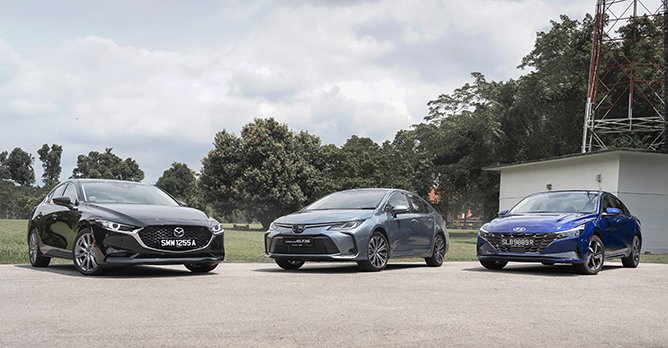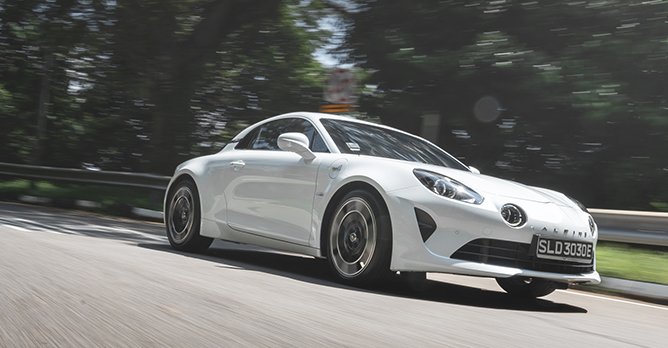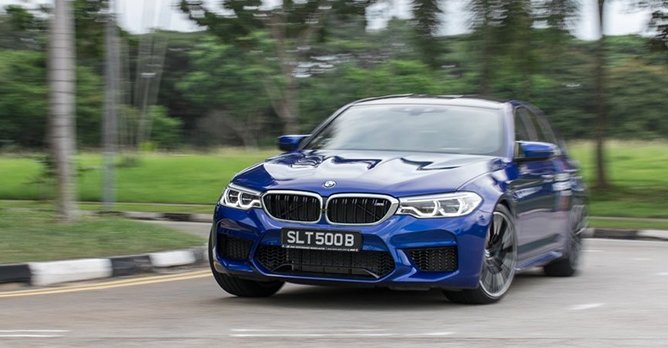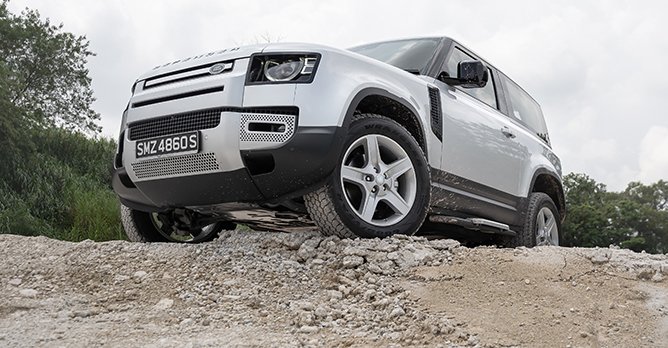Which type of drivetrain suits your driving personality?
29 Jul 2021|8,517 views
Unlike the pull-back toy cars that you had when you were a kid, cars aren't all driven by their rear pair of wheels. Different drivetrain configurations can be found on different types of cars, and each resulting in vast differences to how the car drives.
Did you wonder why so many people were kicking up a huge fuss when BMW introduced front-wheel drive cars to its lineup? Did you scratch your head when the salesperson at the showroom was telling you how the all-wheel drive system on that SUV is what you need? Fret not, here's what you need to know about the different drivetrains and how it will affect you.
Front-wheel drive (FWD)
Contrary to what you might assume, front-wheel drive cars are likely to be the most common drivetrain. While in the past, most cars are rear-wheel driven, the introduction of the transversely mounted engine and the transaxle up front, signalled the shift to front-wheel drive for most economy cars.
The front-engine, front-wheel drive layout removes the need for a bulky transmission tunnel and rear differential - the complicated bits are kept to the engine bay area, allowing a spacious cabin with a relatively flat floor.
Front-wheel driven cars are also favoured for its easy handling characteristics. As the front powered wheels pulls the car along, in the instance where the car loses traction, it will be less likely to spin out of control as it will naturally understeer.
However, tasking the front wheels with both the steering and propulsion of the vehicle taxes the tyres out and often result in poorer performance. As such, most econoboxes which places an emphasis on practicality, such as the Toyota Corolla and MPVs, are front-wheel driven.
If you are looking for a car that is practical and easy to drive, front-wheel drive is likely what you'll want.
Rear-wheel drive (RWD)
It's pretty much self explanatory - the rear wheels pushes the car along. Unlike front-wheel driven cars, the front wheels only have to deal with steering the car.
This 'fairer' distribution of workload means rear-wheel drive cars are what you want for performance driving - just look at the upper echelons of road racing such as F1.
While almost all front-wheel driven cars have their engine in front, rear-wheel driven cars are found with various engine layouts. Sedans such as the BMW 3 Series can be found with a front-engine, rear-wheel drive layout, Porsche 911s are traditionally rear-engine, rear-wheel driven, while supercars tend to have their engines sitting near to the centre of the car for excellent weight distribution.
But rear-wheel drive cars often demands a skilful driver because in low grip conditions, it is easy for the rear end of the car to break loose under power, resulting in a spin.
The rear-wheel drive layout is perfect for a sporty driver that places an emphasis on driving dynamics.

Sgcarmart
Ask your preferred dealer for Sgcarmart Warranty
You can ask the dealer to include the warranty with your car purchase!
Read more about WarrantyAll-wheel drive (AWD)
All-wheel drive cars have power sent to all four wheels to provide excellent traction, even on unfavourable surfaces. While it might sound like the best layout to build a car on, it isn't without its cons.
All-wheel drive systems are heavy and can be complicated. And this translates to poorer fuel economy, and complexity in repairs - things you do not want in a daily driver.
Of course, the superior traction will come in handy in high powered performance cars. That's why even high-performance sedans that were rear-wheel driven, such as the BMW M cars and Mercedes-Benz AMG cars are now offered with all-wheel drive.
Love to drive enthusiastically but prefer something easier to handle and go fast? Well, the AWD layout is just for you.
Four-wheel drive (4WD)
No, it isn't the same as all-wheel drive. I do admit the nomenclature is rather confusing…
While four-wheel drive cars are also driven by all four wheels, however, unlike all-wheel drive cars, it is configured for off-roading.
In older off-roaders, four-wheel drive is a part time system that one should only use in extremely low traction conditions. By pulling a lever or pressing a button, the car will lock both the front and rear axles to turn at the same speed.
If you were to drive a car locked in four-wheel drive mode, and locked differentials on a paved road, the car will not only turn poorly, you will also stress out the drivetrain, risking damages to it.
However, recent off-roaders like the new Land Rover Defender adopts a permanent four-wheel drive system that offers the capability of a a traditional four-wheel drive system, as well as the convenience and ease of use of an all-wheel drive system.
Want to go to places that others can't and roads that are less travelled? There's nothing that will suit you more than a four-wheel drive equipped off-roader.
Here are some related articles that might interest you
A guide to One Motoring services for Singaporean drivers
Buying a car - what to look out for during your test drive
Buying a car - is a facelifted model the right choice for you?
Thinking of buying a car? Which type of car suits you?
Buying a used car? Make sure it's covered under sgCarMart Warranty!

Sgcarmart
Ask your preferred dealer for Sgcarmart Warranty
You can ask the dealer to include the warranty with your car purchase!
- Eligible for all passenger cars less than 15 years old
- Get this warranty through most car dealers in Singapore
Unlike the pull-back toy cars that you had when you were a kid, cars aren't all driven by their rear pair of wheels. Different drivetrain configurations can be found on different types of cars, and each resulting in vast differences to how the car drives.
Did you wonder why so many people were kicking up a huge fuss when BMW introduced front-wheel drive cars to its lineup? Did you scratch your head when the salesperson at the showroom was telling you how the all-wheel drive system on that SUV is what you need? Fret not, here's what you need to know about the different drivetrains and how it will affect you.
Front-wheel drive (FWD)
Contrary to what you might assume, front-wheel drive cars are likely to be the most common drivetrain. While in the past, most cars are rear-wheel driven, the introduction of the transversely mounted engine and the transaxle up front, signalled the shift to front-wheel drive for most economy cars.
The front-engine, front-wheel drive layout removes the need for a bulky transmission tunnel and rear differential - the complicated bits are kept to the engine bay area, allowing a spacious cabin with a relatively flat floor.
Front-wheel driven cars are also favoured for its easy handling characteristics. As the front powered wheels pulls the car along, in the instance where the car loses traction, it will be less likely to spin out of control as it will naturally understeer.
However, tasking the front wheels with both the steering and propulsion of the vehicle taxes the tyres out and often result in poorer performance. As such, most econoboxes which places an emphasis on practicality, such as the Toyota Corolla and MPVs, are front-wheel driven.
If you are looking for a car that is practical and easy to drive, front-wheel drive is likely what you'll want.
Rear-wheel drive (RWD)
It's pretty much self explanatory - the rear wheels pushes the car along. Unlike front-wheel driven cars, the front wheels only have to deal with steering the car.
This 'fairer' distribution of workload means rear-wheel drive cars are what you want for performance driving - just look at the upper echelons of road racing such as F1.
While almost all front-wheel driven cars have their engine in front, rear-wheel driven cars are found with various engine layouts. Sedans such as the BMW 3 Series can be found with a front-engine, rear-wheel drive layout, Porsche 911s are traditionally rear-engine, rear-wheel driven, while supercars tend to have their engines sitting near to the centre of the car for excellent weight distribution.
But rear-wheel drive cars often demands a skilful driver because in low grip conditions, it is easy for the rear end of the car to break loose under power, resulting in a spin.
The rear-wheel drive layout is perfect for a sporty driver that places an emphasis on driving dynamics.

Sgcarmart
Ask your preferred dealer for Sgcarmart Warranty
You can ask the dealer to include the warranty with your car purchase!
Read more about WarrantyAll-wheel drive (AWD)
All-wheel drive cars have power sent to all four wheels to provide excellent traction, even on unfavourable surfaces. While it might sound like the best layout to build a car on, it isn't without its cons.
All-wheel drive systems are heavy and can be complicated. And this translates to poorer fuel economy, and complexity in repairs - things you do not want in a daily driver.
Of course, the superior traction will come in handy in high powered performance cars. That's why even high-performance sedans that were rear-wheel driven, such as the BMW M cars and Mercedes-Benz AMG cars are now offered with all-wheel drive.
Love to drive enthusiastically but prefer something easier to handle and go fast? Well, the AWD layout is just for you.
Four-wheel drive (4WD)
No, it isn't the same as all-wheel drive. I do admit the nomenclature is rather confusing…
While four-wheel drive cars are also driven by all four wheels, however, unlike all-wheel drive cars, it is configured for off-roading.
In older off-roaders, four-wheel drive is a part time system that one should only use in extremely low traction conditions. By pulling a lever or pressing a button, the car will lock both the front and rear axles to turn at the same speed.
If you were to drive a car locked in four-wheel drive mode, and locked differentials on a paved road, the car will not only turn poorly, you will also stress out the drivetrain, risking damages to it.
However, recent off-roaders like the new Land Rover Defender adopts a permanent four-wheel drive system that offers the capability of a a traditional four-wheel drive system, as well as the convenience and ease of use of an all-wheel drive system.
Want to go to places that others can't and roads that are less travelled? There's nothing that will suit you more than a four-wheel drive equipped off-roader.
Here are some related articles that might interest you
A guide to One Motoring services for Singaporean drivers
Buying a car - what to look out for during your test drive
Buying a car - is a facelifted model the right choice for you?
Thinking of buying a car? Which type of car suits you?
Buying a used car? Make sure it's covered under sgCarMart Warranty!

Sgcarmart
Ask your preferred dealer for Sgcarmart Warranty
You can ask the dealer to include the warranty with your car purchase!
- Eligible for all passenger cars less than 15 years old
- Get this warranty through most car dealers in Singapore






















